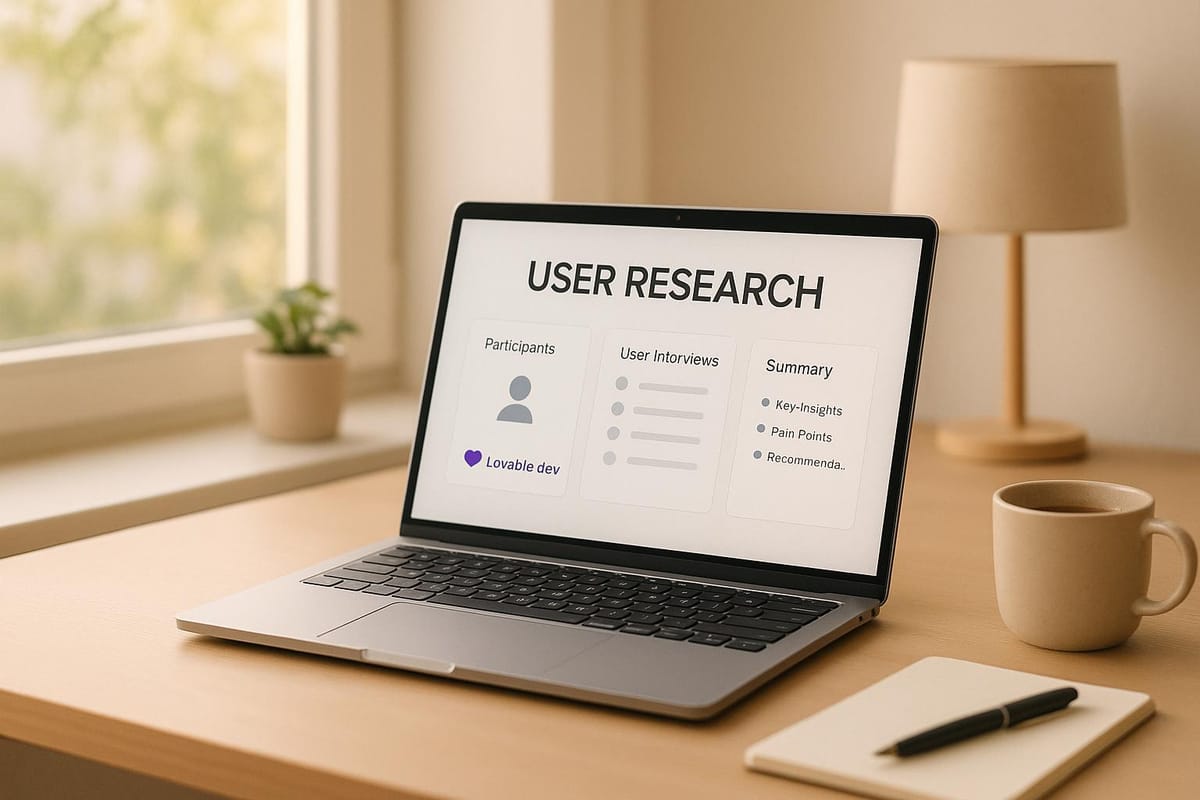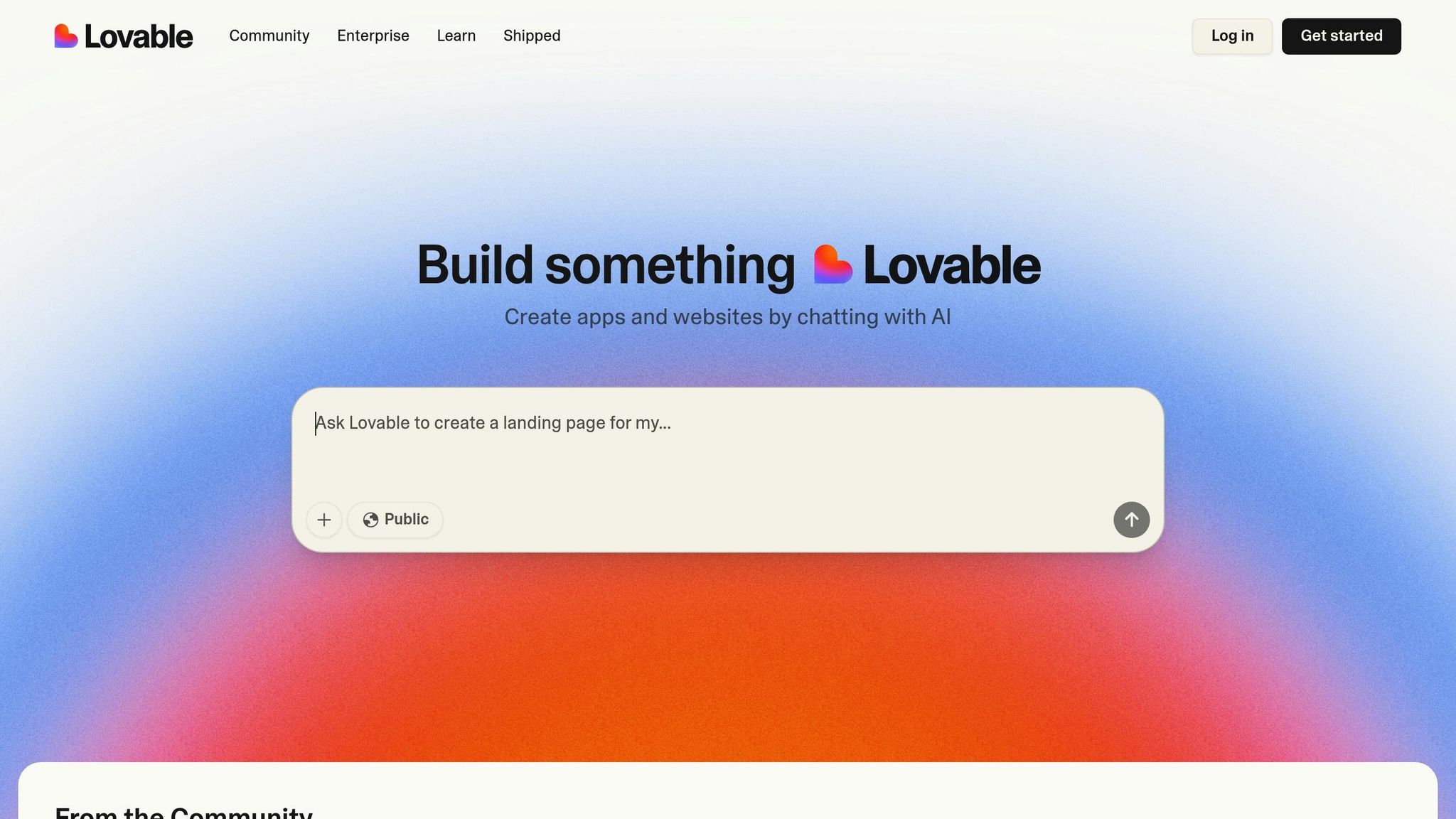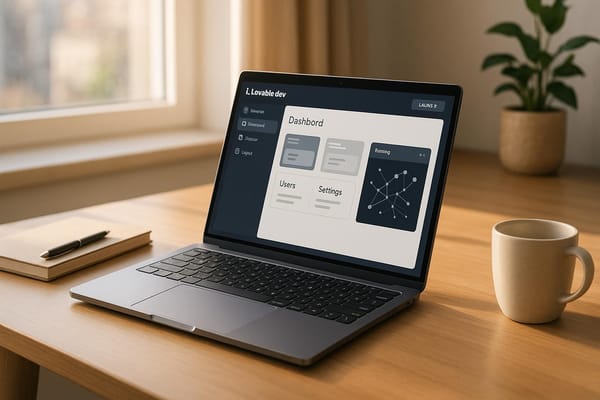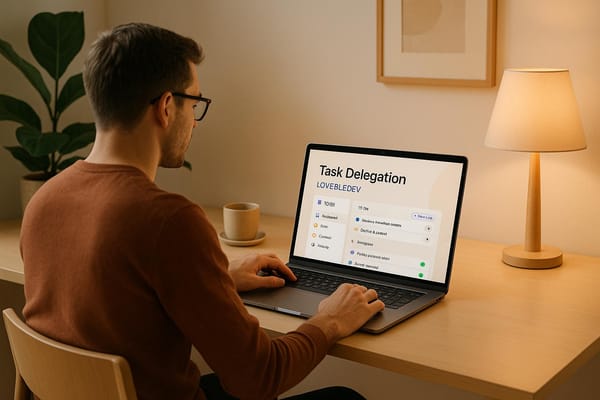How to Conduct Remote User Research for Lovable.dev Apps
Learn how to effectively conduct remote user research for app development, ensuring your project meets real user needs and enhances usability.

Remote user research is essential for building better apps on Lovable.dev. It helps you understand how users interact with your app, no matter where they are, and provides actionable feedback to improve usability, save costs, and speed up development. Lovable.dev’s AI-powered tools make app creation accessible, but remote research ensures your app meets real user needs.
Key Takeaways:
- Why It Matters: Remote research is faster, cheaper, and more inclusive, allowing you to gather feedback from diverse users.
- How to Start:
- Define clear research goals (e.g., "Can users complete onboarding in 3 minutes?").
- Identify your target audience and their needs.
- Use Lovable.dev’s community and tools like Loveableapps.ai for participant recruitment.
- Best Methods:
- Remote usability testing (moderated and unmoderated).
- Surveys and interviews for detailed feedback.
- Behavioral analytics to track user actions.
- Tools to Use: Platforms like Maze, Hotjar, and UXtweak integrate seamlessly with Lovable.dev for usability testing, feedback collection, and analytics.
Quick Comparison of Research Tools:
| Tool | Starting Price | Best For | Key Feature |
|---|---|---|---|
| Maze | $75/month | Usability testing | Continuous discovery |
| Hotjar | $32/month | Behavior analytics | Heatmaps and session tracking |
| Lyssna | $75/month | Quick validation | First-click studies |
| Userfeel | $60/credit | Targeted feedback | User recordings |
| UXtweak | €99/month | Multi-method research | Card sorting, prototypes |
Next Steps: Start small - validate your app idea with a few users, use Lovable.dev’s rapid prototyping, and refine based on feedback. Engage with the Lovable.dev community and Loveableapps.ai for resources, participant recruitment, and best practices.
Remote usability testing: A step-by-step | Maze

Setting Up Remote User Research for Lovable.dev Apps

Starting remote user research takes thoughtful planning and preparation. A solid setup ensures you gather meaningful insights that can drive improvements for your app.
The process boils down to three key steps: setting clear research goals and identifying your target audience, recruiting the right participants, and selecting research methods that align with your app's development stage. These steps create a strong foundation for gathering insights throughout your app's lifecycle.
Define Research Goals and Target Users
The first step is to establish clear, specific research objectives. Vague goals won’t provide the focus you need to make meaningful improvements. Start by identifying the specific problem your app is solving and who experiences that problem the most.
Pinpoint the Problem or Need: Great apps solve real challenges or inefficiencies. Instead of asking broad questions like "Do people like my app?", aim for more actionable ones. For example, "Can users complete the onboarding process in under three minutes?" or "Do users grasp the main value of the app within 30 seconds of opening it?"
Understand Your Target Audience: Define your ideal users by studying their demographics, behaviors, and needs. For apps built on Lovable.dev, this often involves gauging users' technical comfort levels and how they interact with the app. For instance, a productivity app might target small business owners who prefer simple, efficient solutions.
Creating a Product Requirements Document (PRD) can help sharpen your research focus. As noted in the Lovable Documentation:
"Capture essential project details in a living document that evolves with your app."
Your PRD should include user personas, key features, and success metrics. This roadmap keeps your research aligned with your app's goals and helps you measure progress effectively.
When defining your target audience, keep it simple by focusing on an MVP (Minimum Viable Product) approach. Test whether users can complete essential tasks before layering in advanced features. Tools like Google Analytics and surveys can provide deeper insights into user behavior. Additionally, forums, customer reviews, and social media discussions can highlight recurring challenges that inform your research goals.
Clear goals will help you choose the right participants and methods for your study.
Find Participants from the Lovable.dev Community
The Lovable.dev ecosystem makes finding participants easier. This community already understands the platform’s strengths and limitations, which can lead to more relevant feedback.
Leverage the Lovable.dev Network: Loveableapps.ai is a great place to start. The creator showcase connects you with other builders who’ve faced similar challenges. These participants are familiar with the platform’s rapid development cycle and can offer insights tailored to its features.
Define Your Ideal Participant Profile: Before recruiting, outline your participant criteria based on psychographics, behaviors, demographics, and geographics. For example, if your app is for small business owners, consider their technical skills and industry-specific needs.
Use Screener Surveys Effectively: Keep screener surveys short - under 10 questions - and focus on behavioral insights rather than demographics. Instead of asking, "Are you a small business owner?", ask, "How often do you use productivity apps to manage your business tasks?" Avoid revealing too much about your study’s purpose, and steer clear of leading questions. Include questions that assess how articulate participants are, such as, "Describe a recent frustrating experience with a mobile app."
Offer Incentives: Compensate participants fairly for their time. Match the incentive to the level of effort required for each session.
When reaching out, explain why you’re contacting them, the context of the research, and why their input is valuable. Mention any incentives and include a clear call to action. Highlighting how their feedback will improve the Lovable.dev ecosystem can be especially motivating within this collaborative community.
Choose the Right Research Methods for Development Stages
Your research methods should align with your app’s development stage. Each stage requires a different approach to gather the most useful insights.
Early Stage (Idea to Prototype): At this stage, use Lovable.dev’s chat mode to brainstorm and plan your idea. Move to edit mode only after your vision is clear. Focus on validating your concept with interviews and surveys. Ask potential users about their current solutions, pain points, and openness to trying new approaches.
Lovable.dev supports Wizard-of-Oz Prototyping, which allows you to simulate a finished experience and test user interactions before committing to full development. This makes early-stage research especially effective, as you can refine ideas without heavy investment.
Prototype Stage: With a working prototype, conduct remote usability testing to identify navigation and comprehension issues. Focus on core user flows and essential features. Test whether users understand your app’s purpose and can complete key tasks without help.
Active Development Stage: As your app evolves, shift to tracking user behavior and gathering continuous feedback. Use this data to make regular updates. For example, in February 2025, the One Love Foundation used Lovable.dev to launch a fundraising website. They raised $150,000 - 50% above their target - secured over 200 monthly donors, and increased web traffic to their educational content.
Post-Launch Optimization: After launch, combine analytics with user feedback sessions. Use A/B testing to refine features and conduct interviews to understand changing user needs.
Lovable.dev’s rapid iteration capabilities make it easy to test, learn, and improve at every stage. The platform’s design philosophy emphasizes creating products that feel intuitive and accessible:
"Lovable believes in crafting AI products that feel intuitive, engaging, and accessible. They prioritize user-centric design, ensuring every feature serves a real-world need."
Key Remote Research Methods for Lovable.dev Apps
Understanding how users interact with your Lovable.dev app is crucial, and remote research methods offer a flexible way to gather this information. Each method serves a specific purpose and works best at different stages of development. Here’s a breakdown of some effective techniques for your project.
Remote Usability Testing
Remote usability testing allows you to observe how users interact with your app in their natural environment, eliminating the need for travel. This method comes in two main forms:
- Moderated Testing: A facilitator guides participants in real-time, asking follow-up questions and exploring the reasons behind their actions. This approach is ideal for diving into complex tasks.
- Unmoderated Testing: Participants complete tasks independently using preset instructions, with screen recordings capturing their interactions. This method works well for simpler workflows and larger participant groups.
To get started, define clear objectives. Instead of asking broad questions like, "Is my app easy to use?" focus on specifics, such as, "Can users set up an account within two minutes?" Scenarios should mirror real-world use cases, like creating a shared task list for a meeting. Recruiting a diverse group of participants and encouraging honest feedback will provide richer insights.
| Feature | Moderated Testing | Unmoderated Testing |
|---|---|---|
| Data Collection | In-depth qualitative insights | Broad quantitative data |
| Time Investment | Requires live scheduling | Faster, asynchronous process |
| Scalability | Limited by facilitator capacity | Ideal for large-scale testing |
| Best Uses | Understanding complex behaviors | Testing straightforward flows |
| Cost | Higher due to facilitation | Lower, thanks to automation |
These methods help you gather actionable user feedback, especially during the later stages of development.
Surveys, Questionnaires, and Interviews
Pair usability testing with tools like surveys and interviews to gather detailed user opinions. These methods can help you capture valuable insights and refine your app’s design.
Here are a few common approaches:
- Multiple-Choice Questionnaires: Great for collecting numerical data, like satisfaction scores or feature usage frequency.
- Open-Ended Questions: Useful for uncovering unique user experiences or identifying potential issues.
- Likert-Scale Surveys: Measure user satisfaction or agreement on a scale, providing data that can be tracked over time.
- Single-Choice Questions: Ideal for quick feedback after specific interactions, such as completing onboarding.
Timing is everything - sending a survey right after a key event, like user onboarding or a support interaction, can increase engagement. As one participant shared:
"I love having the opportunity to share how I use products and what I would change, knowing that my input might actually impact the end product. Plus the rewards are great!" – Aaron J.
Combining these qualitative insights with behavioral data gives you a well-rounded view of user engagement.
Behavioral Analytics and Tracking
Behavioral analytics offer an objective look at how users navigate your app, complementing the subjective feedback from surveys and usability tests. Key metrics to monitor include load times, crash reports, retention rates, and conversions.
Tools like Firebase work seamlessly with Lovable to provide real-time insights into user behavior. Custom dashboards can help you identify trends quickly, while in-app feedback loops blend usage data with direct user sentiment.
For example, when Debtfreeo v2.0 was built with Lovable.dev, it saw a 30% boost in engagement after introducing in-app surveys. Lead developer Alex Nguyen credited better error controls for improving user retention.
A/B testing is another powerful tool - by comparing different versions of features like onboarding flows or button placements, you can fine-tune your app’s performance. Combining analytics with user feedback helps you identify and address bottlenecks, ensuring a smoother experience for your users.
Tools and Resources for Remote User Research in the Lovable.dev Ecosystem
Picking the right tools for user research can make all the difference when it comes to gathering meaningful insights. Fortunately, there are several platforms that mesh seamlessly with Lovable.dev’s workflow, helping you collect and analyze user data more efficiently.
Research Tools Compatible with Lovable.dev
Maze is a popular choice for Lovable.dev users. It offers a free plan with paid options starting at $75/month. Maze specializes in unmoderated usability testing, which works well for prototypes and live apps. Its focus on continuous discovery makes it a great fit for the iterative development cycles that Lovable.dev projects often follow.
For tracking user behavior, Hotjar is a go-to tool. Starting at $32/month, it provides heatmaps, session recordings, and feedback polls. These features integrate easily with Lovable.dev-built web apps, offering a visual way to see how users interact with your app. The heatmaps are especially helpful for pinpointing the most-clicked areas of your interface.
If you're looking for a budget-friendly option, Lyssna (formerly UsabilityHub) is worth considering. It allows free testing for sessions up to two minutes, with paid plans starting at $75/month. Lyssna is ideal for quick usability tests and first-click studies, which are great for validating specific features in your app.
For smaller projects, Userfeel offers a pay-as-you-go model at $60 per credit. Each credit gets you user recordings and feedback, making it a cost-effective option when you need targeted insights for particular features.
UXtweak is another versatile tool, starting at €99/month with a free plan available. It supports a variety of research methods, including card sorting, tree testing, and prototype testing. This flexibility makes it a strong choice for Lovable.dev builders who want to explore multiple aspects of their app’s user experience.
| Tool | Starting Price | Best For | Key Feature |
|---|---|---|---|
| Maze | $75/month (free plan) | Continuous discovery | Unmoderated usability testing |
| Hotjar | $32/month | Behavior analytics | Heatmaps and session recordings |
| Lyssna | $75/month (free for short tests) | Quick validation | First-click studies |
| Userfeel | $60/credit | Targeted research | User recordings |
| UXtweak | €99/month (free plan) | Multi-method research | Card sorting, tree testing, prototypes |
For managing participant recruitment, User Interviews offers structured options. Their Recruit plan starts at $49/session, while the Research Hub plan is $500/month. These tools are particularly useful when you need to target specific user demographics for your testing.
Many of these tools also integrate with design platforms like Figma, which is convenient since Lovable.dev builders often begin their projects with design mockups. Tools like Maze and Hotjar can automatically analyze user data, saving you time and effort.
Additionally, Loveableapps.ai serves as a valuable resource to complement these tools.
Using Loveableapps.ai to Improve Research

Loveableapps.ai is more than just an app directory - it’s a treasure trove for understanding what works within the Lovable.dev ecosystem. Its App Directory and Creator Showcase sections are particularly helpful.
The App Directory lets you explore common design patterns and identify areas for improvement. For example, if you’re building a productivity app, you can see how other creators have tackled onboarding flows or organized features. This can give you a head start in shaping your own app’s user experience.
The Creator Showcase connects you with experienced Lovable.dev builders. These creators often share insights about their research methods, recruitment strategies, and how they’ve incorporated user feedback into their development process. Learning from their experiences can help you refine your own research approach.
Loveableapps.ai also offers Learning Resources, including tutorials and guides that show how to integrate research findings into your Lovable.dev workflow. These resources cover everything from prompt engineering to implementing features based on user feedback, making it easier to turn insights into action.
The platform highlights success stories to inspire your own projects. For instance, in 2024, Sherlock, an AI-powered recruitment tool built on Lovable.dev, saved recruiters over 136 workdays annually by automating processes. This illustrates how addressing user pain points can lead to major efficiency gains and improved satisfaction.
Another standout example is Ai ChatPDF, an app that allows users to analyze and extract content from PDFs using natural language. This demonstrates how Lovable.dev can be used to create tools that efficiently process and respond to user input, offering inspiration for your own research methods.
Finally, the Best Practices section on Loveableapps.ai provides detailed guidance on integrating user feedback into prompt engineering. This is particularly helpful for fine-tuning your app’s behavior within Lovable.dev’s AI-driven environment, ensuring your app evolves based on real user needs.
These resources and tools make it easier to create user-centered apps while streamlining the research process in the Lovable.dev ecosystem.
Turn Research Insights into App Improvements
Turning research insights into real app improvements is an essential step in building successful Lovable.dev applications. This involves carefully analyzing what you’ve learned and translating those findings into meaningful updates that benefit your users.
Once you’ve gathered insights using the recommended methods and tools, the challenge is to turn those discoveries into practical enhancements for your app.
Analyze and Organize Research Data
Start by breaking down your raw data into clear, actionable themes. As UX researcher JJ Knowles explains:
"It's the act of taking raw data and turning it into something useful."
Plan your approach to analysis before diving into the data. Ask yourself what you’re trying to uncover and what questions need answering - this keeps your focus sharp and ensures you extract insights you can act on. Taking notes immediately after each session can also help capture fresh observations.
When it’s time to dig deeper, examine your entire dataset for recurring patterns and themes. For quantitative data, such as analytics and survey results, pay close attention to metrics like success rates, task completion times, and error rates. Demographic details can also reveal whether specific user groups are experiencing unique challenges.
"Regardless of whether you're dealing with a numeric dataset or a verbal interview, you're always on the lookout for patterns and themes that can tell you something meaningful about the user, the product, or both." - Career Foundry
Prioritize your findings by focusing on the most critical issues and the number of users affected. For instance, a navigation issue impacting a majority of users should take precedence over a minor feature request from a single user. Present your insights in a structured format backed by evidence, with clear recommendations for action.
With your findings organized, you can move on to testing and refining your app to ensure those changes have the desired impact.
Test Repeatedly and Improve Continuously
Regular testing and refinement are the backbone of creating a better app. Make testing a consistent part of your workflow, whether through weekly usability sessions or monthly in-depth reviews. The key is consistency - find a schedule that works for your team and stick to it.
When implementing changes based on research, introduce them incrementally. Testing one or two updates at a time allows you to measure their specific impact and adjust as needed.
Use Community Feedback for App Refinement
In addition to structured testing, leverage direct feedback from your community to understand user needs in real-time. The Lovable.dev platform is a powerful tool for gathering ongoing input, thanks to its built-in feedback system. Users can share their thoughts directly, categorizing their input as bug reports, feature requests, integration ideas, or general questions.
Keep an eye on the Lovable changelog to track common issues and learn how other successful apps evolve over time.
Another helpful resource is Loveableapps.ai. Its Creator Showcase connects you with experienced app builders who can share strategies for collecting and acting on feedback. Meanwhile, the App Directory provides insights into user engagement patterns, helping you identify which features resonate most with your audience.
Engage actively with the Lovable.dev community to gain fresh perspectives. Peer reviews often uncover issues that formal testing might miss. Simple feedback loops - like rating systems, quick surveys, or direct contact options - make it easy for users to share their thoughts. Tracking which suggestions lead to real improvements not only makes your app better but also shows users that their input truly matters.
Conclusion: Build Better Apps with Remote User Research
By applying the remote research methods discussed earlier, you can create more effective and engaging Lovable.dev apps. With 500,000 users building over 25,000 new products daily using Lovable, incorporating real user insights becomes essential for success.
Lovable's fast development tools, which "handle 80% of MVP design", give indie makers the freedom to focus on the crucial 20% that addresses actual user needs. As Lovable's founder, Anton Osika, put it, "dropping the barrier to entry to build products was the goal". However, while the technical hurdles are lowered, the importance of user validation remains critical.
Key Takeaways for Lovable.dev Builders
- Start with clear research goals. Before diving into development, validate your target audience to save time and effort. Lovable’s AI-powered platform makes it tempting to build first, but asking the right questions early pays off in the long run.
- Tap into the Lovable.dev community and Loveableapps.ai. The platform offers a wealth of user insights. The App Directory highlights successful apps, while the Creator Showcase connects you with experienced builders who can share valuable lessons.
- Align your research methods with your development stage. Tools like Lovable can save developers 5–6 hours per week. Use that time for focused research, whether it’s quick surveys during the brainstorming phase, usability testing during prototyping, or analyzing user behavior post-launch.
Next Steps for Indie Makers and Small Teams
Here’s how solo developers and small teams can put these ideas into action:
- Validate before perfecting. Ask potential users, "Would this help you?" before committing weeks to development. Lovable’s Chat Mode is great for brainstorming features, but user feedback should guide your decisions.
- Solve your own problems, then test widely. Use Lovable’s rapid prototyping tools to create solutions for challenges you face personally, and then see if others share the same need.
- Establish feedback loops early. Simple mechanisms like surveys, ratings, or direct contact options can help you gather user insights from day one. This allows you to iterate based on real behavior rather than assumptions.
- Think beyond code - focus on design and usability. Lovable simplifies the technical side, giving you more room to prioritize user experience and product-market fit. Build apps that not only work but also address real problems with elegance.
The future belongs to creators who combine AI-driven speed with meaningful user insights. Remote research is your edge in this competitive landscape - one developer even managed to build 30 apps in 30 days. Make sure every app you create solves genuine user needs.
FAQs
What’s the best way to recruit participants for remote user research on Lovable.dev apps?
To bring participants on board for remote user research on Lovable.dev apps, start by using the Lovable.dev platform’s built-in tools. Features like AI-powered recruitment portals make it simple to organize and manage participants efficiently. Another great approach is to tap into the Lovable.dev community - share app success stories and invite both creators and users to collaborate on refining and enhancing the apps. You can also create private online groups or communities to connect with users who are genuinely interested in contributing. These methods are excellent for finding participants who are passionate about improving and shaping the future of Lovable.dev apps.
What’s the difference between moderated and unmoderated remote usability testing, and when should I choose each?
Moderated vs. Unmoderated Remote Usability Testing
Moderated remote usability testing involves having a facilitator actively guide the session. The facilitator observes how participants interact with the product, asks follow-up questions, and collects detailed feedback. This approach works particularly well during the early stages of development or when you're dealing with intricate features and workflows that require more context and explanation.
Unmoderated testing, by contrast, lets participants complete tasks on their own without any real-time supervision. This method is ideal for gathering quick feedback from a larger audience or testing straightforward tasks in an environment that mirrors how users would naturally interact with the product.
Here’s a quick way to decide:
- Use moderated testing when you need richer, qualitative insights and the chance to engage directly with users.
- Go with unmoderated testing if you’re looking for speed, scalability, and insights into how users behave in a more organic, unsupervised setting.
How can I use behavioral analytics to enhance the user experience of my Lovable.dev app?
To make your app more user-friendly, take advantage of Lovable.dev's built-in analytics tools. These tools let you monitor user activity, engagement levels, and behavior patterns in real time. With this data, you can uncover where users might struggle and make targeted improvements to enhance usability.
On top of that, reviewing user feedback and tracking behavioral trends can help you spot problem areas and fine-tune your app's design and functionality. By regularly updating and refining your app based on these insights, you can deliver a smoother experience that keeps users engaged and encourages them to stick around longer.



